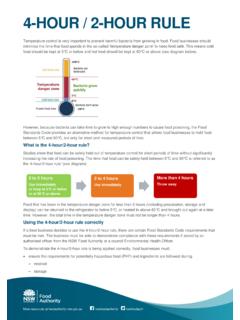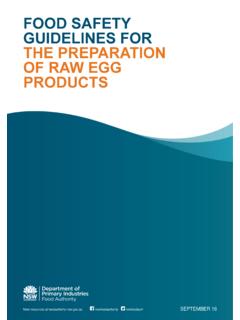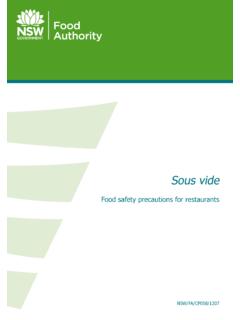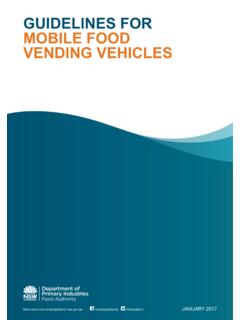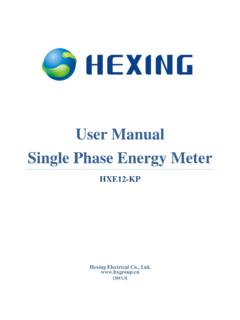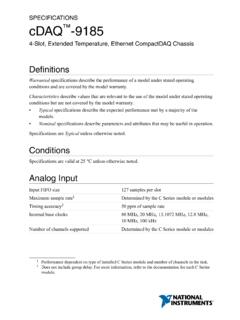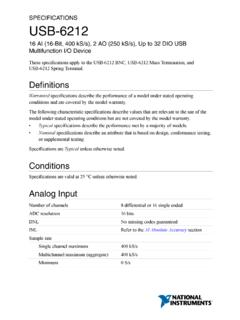Transcription of FOOD SAFETY SCHEMES MANUAL
1 More resources at nswfoodauthorrity nswfoodauth AUGUST 2019 food SAFETY SCHEMES MANUAL 2 Contents Introduction .. 3 Microbiological testing must be done in a NATA approved laboratory .. 3 Some tests can be done in-house .. 3 frequency of testing .. 4 Reporting of failures .. 4 Definition .. 5 Acronyms .. 5 Chapter 1 Dairy food SAFETY scheme .. 6 Dairy processing .. 6 Chapter 2 Egg food SAFETY scheme .. 12 sampling and analysis .. 12 Chapter 3 Meat food SAFETY scheme .. 13 Abattoirs .. 13 Meat and poultry meat processing plants.
2 13 Meat retail premises .. 16 Rendering plant .. 17 Chapter 4 - Plant Products food SAFETY scheme .. 18 sampling and analysis .. 18 Chapter 5 Seafood SAFETY scheme .. 21 sampling and analysis .. 21 Specific requirements .. 22 Chapter 6 Vulnerable persons food SAFETY scheme .. 23 sampling and analysis .. 23 Specific requirements .. 23 Central Processing Unit .. 23 3 Introduction The NSW food Authority (the food Authority) has prepared the NSW food SAFETY SCHEMES MANUAL (the MANUAL ) to specify certain requirements for the following food SAFETY SCHEMES under the food Regulation 2015: Dairy food SAFETY scheme Egg food SAFETY scheme Meat food SAFETY scheme Plant products food SAFETY scheme Seafood SAFETY scheme Vulnerable persons food SAFETY scheme The MANUAL applies to all food businesses licensed under these SCHEMES .
3 The requirements referred to in the food Regulation 2015, detailed within this document, are mandatory. All licensees are required to have food SAFETY programs and adhere to good manufacturing practices (GMP). The testing of finished products can be used in investigation, verifying corrective action, assisting in establishing benchmarks and identifying trends. Product testing alone is not sufficient to demonstrate the SAFETY of food because it has a high probability of not identifying contaminated product even when large sample numbers are tested, but it can be used to verify the effectiveness of the control measures outlined in the business food SAFETY program and associated documentation.
4 Microbiological testing must be done in a NATA approved laboratory Every microbiological analysis of finished products and water specified in this MANUAL must be carried out in a laboratory accredited by the National Association of Testing Authorities, Australia (NATA) for the particular type of analysis to be undertaken. A list of NATA accredited laboratories can be found on the NATA website at Through the NATA s Mutual Recognition Arrangement (MRA) , laboratories accredited by the International Laboratory Accreditation Cooperation (ILAC) signatories are considered acceptable.
5 A list of ILAC signatories can be found at Some tests can be done in-house Some tests can be done in-house using a validated method, as indicated in this MANUAL . The only permitted tests that can be conducted in-house without holding NATA accreditation: - antimicrobial drug residues, - pH, and - environmental swabbing for Listeria. It is recommended that in-house laboratories take part in an Inter-laboratory comparison (ILC) program to demonstrate proficiency for the testing being undertaken. If you take part in the inter-laboratory comparison, records of the ILC program must be kept for audit purposes.
6 4 frequency of testing The tables in this MANUAL outline the minimum testing frequencies for licensed businesses. The type of tests and their frequency are influenced by the risk status of the food and based on past experience, and the possibility of the analytes being present in that particular food determined by the risk rating of the food and scientific data. The testing frequency specified is based on the number of batches produced by the food business. A batch is defined as product made using the same process and/or packaged under the same conditions within a 24-hour period.
7 In the case where a product category is specified ( fresh cut), if the business produces more than one variety of this product category, then the business must select a different product line for sampling each time to ensure that, over time, every product line manufactured is included in the sampling plan. Testing must commence with the first batch tested and testing is then conducted at the specified frequency . If a business wishes to implement an alternative sampling plan to that outlined in this MANUAL , the business must submit the proposed variation in writing to the food Authority for approval by completing the Application to vary ready-to-eat product testing form which can be found on the food Authority s website at For more details on how to do microbiological testing, see Appendix 1.
8 Reporting of failures The food Authority must be notified if any sample analysed fails to meet the standard set out in this MANUAL : verbally within 24 hours after the licence holder becomes aware of the results of the analysis ( by phone), and in writing within 7 days after becoming aware of the result of analysis ( by fax, email or letter). The Notification of pathogen detection form must be used and it can be found on the food Authority s website. All notification must be addressed to: The NSW food Authority PO Box 6682 Phone 1300 552 406 Silverwater NSW 1811 Fax 02 9199 8253 Email Please do not contact an individual officer.
9 5 Definition Batch: Product made using the same process or packaged under the same conditions within a 24-hour period, products must undergo the same process steps and have the same general characteristics ( additives, pH and water activity). For example, a cooked roast beef uses different ingredients and undergoes a different process compared to a smoked cured ham, so they must be considered as different batches. Listericidal process: A process that reduces the Listeria monocytogenes microorganism to a safe level.
10 Non-reticulated water: Any water supply not piped into a business by either a water utility or local council. It includes rainwater, ground water ( bore water) and surface water ( dam). Ready-to-eat (RTE) food : A food product that is in a form that does not require additional preparation prior to consumption. Standard Plate Count (SPC), also referred to as Aerobic Plate Count (APC) or Total Viable Count (TVC): A number of viable bacteria in a food product obtained by enumeration of colonies on an agar plate after a certain period of incubation at certain temperature with the presence of oxygen.


